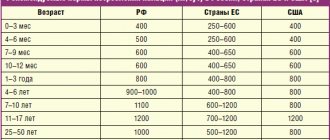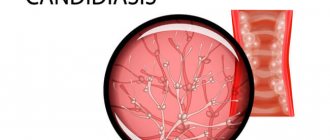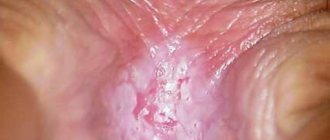What is vaginal candidiasis
Vaginal or vaginal candidiasis is an inflammatory disease when the mucous membrane of a woman’s vagina becomes inflamed.
As a rule, this disease is caused by the presence of yeast-like candida fungi (Latin “Candida albicans”). The type of fungus itself is harmless. The disease is popularly called thrush. It is an extremely common condition that affects women all over the world. A fungus of the genus Candida gets onto a person’s skin and mucous membranes at the time of birth, during the passage of the child through the birth canal. Consequently, this fungus remains our companion throughout our lives. In low concentrations, the fungus does not cause any harm. However, candida manifests its pathogenicity only when immunity decreases.
Symptoms of vaginal candidiasis
As a rule, women with candidiasis complain of curdled, white, sometimes sticky vaginal discharge. The most common symptom is itching (colpitis), which intensifies during long walking and running, during the menstrual cycle. There are also unpleasant pain sensations during sexual intercourse and when urinating. More than 30% of patients experience redness of the external genitalia. Despite the fact that thrush is most often transmitted sexually, the World Health Organization does not list this as the main cause of the disease.
The disease occurs over a long period of time. It may be accompanied by exacerbations and latent asymptomatic conditions. Our clinic provides fast and effective medical care. Qualified doctors prescribe the most optimal course of treatment for patients.
Etiology of VK
Candida spp., the causative agents of vaginal candidiasis, are opportunistic fungi that are the most common cause of fungal infections in humans. The genus Candida has about twenty species. As a rule, BK is associated with one species of Candida, but there is a probability (2-5%) of simultaneous infection with two or more species.
In Russia, the USA, Australia and Europe, Candida albicans is most often detected in women with VK (76-89%). It is followed by C. glabrata (7-16%). The percentage of non-albicans Candida ranges from 11 to 24%. Some studies have shown a trend toward an increase in the incidence of non-albicans candidiasis, but recent work by scientists in the United States involving ninety thousand samples refuted this assertion: the proportion of Candida species causing BK remained virtually unchanged from 2003 to 2007.
Etiologically, various candidiasis are clinically very similar, however, atypical pathogens are characterized by resistance to azole antimycotics. C. glabrata and C. krusei are more resistant to azole antifungal drugs than others.
CC dossier
Marina Pozdeeva
pharmacist of the first category and head of the pharmacy. Author of numerous works on pharmacology and pharmacotherapy, Dnepropetrovsk.
These data highlight the importance of identifying Candida spp. in women with a high risk of developing non-Candida albicans-associated VK in order to select effective therapy for the disease.
Thrush in men
In 40% of cases, men are carriers of the pathogen Candida Albicans; it is present in their microflora, but does not cause significant harm to health. When stress occurs, low immunity or chronic fatigue, a fungal infection can take over the rest of the microflora and provoke disease.
It must be said that due to the anatomical features of the male body structure, candidiasis in the stronger sex is much less common than in women.
In men, the onset of thrush is asymptomatic, since the mobile foreskin and the absence of folds in the groin area allow the development of symptoms to be avoided.
Further development of the disease can occur against the background of pronounced swelling of the genital organ, the appearance of a grayish or whitish coating on the genital organ. Under no circumstances should it be removed, since it covers the affected area, which without it will become even more inflamed.
Since the mucous membrane dries out during thrush, cracks and multiple rashes may appear on the surface of the penis. At first they do not have clear contours, but as the disease progresses, blisters filled with liquid form, and then they transform into erosions. A man may experience discharge from the urethra, which in appearance resembles sour milk.
The urethra becomes inflamed during thrush, so a man may experience discomfort after urinating. If thrush spreads to the entire groin area and scrotum, severe itching appears, which interferes with sleep.
Risk factors
In many healthy women, VC develops sporadically. However, there are risk factors for candidiasis. Behavioral factors include frequent sexual intercourse and oral sex, as well as the use of spermicides.
Tight clothing and underwear usually do not cause illness. However, among women with recurrent VC (RVC), wearing tight tights and panty liners is positively associated with recurrence.
Biological risk factors for VC include:
- use of antibiotics;
- uncontrolled diabetes mellitus;
- genetic predisposition;
- high levels of sex hormones;
- taking oral contraceptives containing high doses of estrogen;
- pregnancy.
Antibacterial drugs help reduce the number of lacto- and bifidobacteria, a shift in pH in the vagina and the growth of Candida spp.
Tetracyclines, cephalosporins and ampicillin are more likely than other broad-spectrum antibiotics to provoke the development of candidiasis.
Pregnancy is one of the most common predisposing factors. According to studies, a third of pregnant women develop VK. High levels of sex hormones increase the glycogen content in the vagina, which in turn provides a constant source of carbon necessary for the growth of fungi.
Additionally, the increased acidity of the vaginal flora during pregnancy may inhibit the growth of other microorganisms that naturally inhibit Candida. Although the initial attachment of fungal cells occurs at higher pH values (6–7), an acidic environment favors mycelial development.
In the pathogenesis of vaginal candidiasis (VC), two main phases are distinguished: the adhesion phase, that is, the attachment of fungal cells to epithelial cells, and the mycelial phase. The mycelial phase begins with the entry of Candida spp. into epithelial cells. The growing pseudomycelium of fungi penetrates into the deep layers of the cervical and vaginal epithelium.
Candida are able to penetrate cells without violating the integrity of their mannoprotein membrane (this is the fibrillar coating of the cell wall of the fungus involved in adhesion processes). As a result, Candida resists defense factors and survives in the macroorganism.
Groups at risk for infection with non-albicans Candida species include:
- women with recurrent VK;
- HIV-infected women;
- women over 50 years of age;
- women with uncontrolled diabetes.
In all of the above groups, the most common species is C. glabrata.
The percentage of cases of non-albicans Candida-associated infection increases with women's age.
Features of RVC
Most women with VK respond quickly to therapy, but some may develop a relapsing form, characterized by four or more episodes of infection per year. Predisposing factors:
- uncontrolled diabetes mellitus;
- taking immunosuppressants;
- deviations in the local vaginal immunity of the mucous membranes;
- genetic predisposition.
Studies have proven that patients with RVC have a higher frequency of specific gene polymorphisms compared to the control group. In addition, these patients have certain Lewis system antigens in their blood.
Intermittent VK may also be associated with decreased in vivo concentrations of mannose-binding lectin. The latter, by binding to sugars on the surface of the Candida cell, triggers the pathway of activation of the complement system and leads to the death of the fungus through complement-mediated phagocytosis.
With this disease, an increased concentration of interleukin-4 is also recorded, which inhibits local protective mechanisms.
The Lewis antigen system depends on a group of genes that are expressed in the glandular epithelium. Lewis antigens, unlike erythrocyte antigens, are components of exocrine epithelial secretions, including vaginal ones.
The role of sexual transmission remains unproven. However, most studies indicate the need for treatment of sexual partners. Thus, an experiment by Dr. Horowitz, UK, demonstrated the presence of Candida species in the ejaculate of men whose partners suffered from RVC.
However, the same Horowitz conducted another study, which studied the results of therapy in 54 women, divided into two groups. Partners from the first group were subjected to antifungal therapy, but those from the second were not. There were no significant differences in the rate of relapse among women in these groups.
Relapses can also be caused by other Candida species that are not equally sensitive to first-line therapy.
Causes
Candidiasis (thrush) affects not only external but also internal organs. The cause of the disease is yeast-like fungi that live in the body of every person.
- Many factors can provoke intensive reproduction of the fungus. For example, hypothermia, illness, stress, changes in hormonal levels (during pregnancy or taking hormonal medications).
- When taking antibiotics, along with pathogenic bacteria, the beneficial microflora of the intestine and vagina, which controls the growth and development of Candida fungi, also dies. The presence of a chronic disease that reduces the activity of the immune system (HIV, sexually transmitted diseases, infections) very often causes candidiasis.
- Candidiasis may be accompanied by endocrine diseases (diabetes, obesity, thyroid dysfunction).
- Finally, candidiasis can be caused by a hot climate or wearing uncomfortable tight or synthetic underwear.
The source of infection with candidiasis, as a rule, is the body’s own flora (autoinfection), but infection can occur from the outside. When causing a disease, the fungus does not change its properties - the body changes its properties (local protection decreases). Attaching to epithelial cells, the pathogenic fungus begins to parasitize them, penetrating deep into the tissues.
In the body's fight against candidiasis, a dynamic balance often arises when the fungus tries to penetrate deeper into the tissue, but cannot, and the body tries to reject it and also cannot. In this case, the process can last for years; a shift in balance in one direction or another will lead either to recovery or to an aggravation of the process.
Candidiasis occurs in several forms depending on certain characteristics.
- Carriage. A person is a carrier of the disease. There are no symptoms of candidiasis and there is no need to treat.
- Acute. Accompanied by itching, rashes, and discharge. Treatment must be comprehensive and high quality. Young children are most often susceptible to infection.
- Chronic. Symptoms subside and manifest; relapses are possible. It develops if it is not treated correctly with antibiotics for a long time, or if hormonal contraceptives are used.
This disease has several varieties, since it does not have an exact localization in the body:
- Urogenital candidiasis in women.
- male.
- Thrush of the lips
- On skin folds (armpits, area between the buttocks, inguinal folds).
- Gastrointestinal tract (stomach, esophagus, intestines, anus).
VK Clinic
Clinical symptoms of VK are nonspecific and may be associated with other vaginal diseases, including bacterial vaginosis, trichomoniasis, chlamydia, and gonorrhea. A distinctive feature of the symptoms is itching and burning. In some cases, dyspareunia (pain during sexual intercourse) and dysuria may develop.
In vivo studies have shown that imidazole antifungals (miconazole and clotrimazole) are less effective in treating non-albicans Candida species. Thus, C. tropicalis and C. glabrata are 10 times less sensitive to miconazole than C. albicans.
Diagnosis of thrush
In most cases, there are no difficulties in making a diagnosis. The doctor asks the patient whether she has had thrush before, what complaints she has, whether she is taking antibiotics, etc.
Usually the diagnosis is made based on symptoms, but in some cases it makes sense to undergo additional examination:
- Detection of Candida albicans in a smear in women - the doctor takes a sample of the discharge with a cotton swab and sends it to the laboratory for analysis.
- Sowing vaginal contents on artificial nutrient media - this analysis allows you to confirm thrush, as well as determine the type of fungus that caused it.
- Serological diagnosis - determination of antibodies to fungal antigens, is prescribed when the pathological process is generalized.
- Molecular biological methods.
- Immunofluorescence diagnostics - prescribed for recurrent thrush.
- A blood test allows you to identify diseases that can trigger the development of thrush.
- Vaginal pH studies are prescribed when treatment for the disease does not have an effect, and symptoms periodically return. If the vaginal acidity is high, this may indicate bacterial vaginosis.
Treatment of uncomplicated VK
Uncomplicated VK is caused by strains of C. albicans, most of which exhibit sensitivity to azole antifungals. Treatment of an uncomplicated disease leads to a positive result in 90% of cases, even when prescribing a single dose of oral or a short course of local antimycotics. There are several topical azole drugs to choose from with approximately equal effectiveness.
The empirical prescription of antimycotics for this form of the disease is completely justified. Moreover, the choice of treatment is often based on the patient's individual preferences.
The Candida cell wall is a complex glycoprotein that depends on the constant synthesis of ergosterol. Azole compounds, which are the active ingredients of azole antifungals, block the production of ergosterol, allowing topical antifungals to be effective in 80-90% of cases.
Azole drugs, which are divided into imidazole and triazole derivatives, are the most numerous and effective group of antifungal agents. Azole antimycotics include both systemic drugs (ketoconazole, fluconazole, itraconazole) and local ones (bifonazole, clotrimazole, isoconazole, econazole and others).
In comparative trials of 10-14-day courses of therapy with azoles and nystatin, the preferential effectiveness of the former was revealed (80-95% of mycological cure compared with 70-80% in the nystatin group). In addition, azoles have proven effective even in short courses of treatment.
Therapy for VK in pregnant women involves the use of local antifungal drugs. Safe topical antimycotics include miconazole and clotrimazole; the recommended course of treatment is seven days. In addition, during pregnancy, the polyene antibiotic natamycin is prescribed. The standard regimen of antifungal therapy with local forms of natamycin is designed for use for three days. If necessary, the course can be doubled.
Complications and consequences of vaginal candidiasis
Thrush can cause psychological problems of a sexual nature due to a lack of understanding of the partner and/or his reluctance to participate in treatment. Negligent treatment of the disease can lead to prolonged depression and many years of expensive treatment.
Vaginal candidiasis is dangerous due to damage to the skin areas in the genital area, an increased risk of severe infections during a period when the body is weakened. Quite often, an advanced form of thrush passes into the stage of a chronic disease, and then this form of the disease involves internal organs in the pathological process. Candida penetrates deeper into the submucosal layer. First of all, the fungus damages nearby organs: the patient’s bladder and intestines. Damage to the genitourinary organs and depression of the condition by other associated infections can develop into kidney disease.
If surgery has been performed on nearby organs, there is a risk of complications after surgery. If treatment is untimely, pregnant women infect their fetus with thrush, which can result in abscesses in the newborn’s oral cavity. In addition, conceiving a child during illness is quite problematic. Changes in the acid-base environment of the vagina do not allow sperm to survive: they simply do not have time to fertilize the egg.
Treatment of complicated RVC
The optimal course of treatment for complicated VK has not yet been precisely determined. Some studies have shown the effectiveness of antifungal suppressive therapy for several months.
The drug of choice for RVC is oral fluconazole. For severe recurrent VK, fluconazole is administered at a dose of 150 mg (three doses) every 72 hours for nine days, after which treatment is continued at 150 mg per week for a long time. This antifungal regimen significantly reduces the likelihood of relapse compared with three doses of fluconazole without maintenance treatment.
Long-term suppressive therapy with oral fluconazole is convenient and well tolerated compared with other antifungal agents. Studies have shown that the effectiveness of a suppressive treatment regimen for RVC reaches 90%. Contrary to expectations, the development of resistance to C. albicans or superinfection with non-albicans species was not confirmed in patients taking fluconazole for a long time. However, in patients with persistent infection, identification of the pathogen is recommended.
Other oral agents that have proven effective in the treatment of RVC can be used as drugs for suppressive therapy. The following are prescribed as alternative treatment regimens:
- ketoconazole 100 mg per day (due to the hepatotoxicity of oral ketoconazole, preference is usually given to other drugs);
- itraconazole 200 mg twice a day for one day every month;
- clotrimazole vaginal suppositories.
For women who prefer topical treatment, clotrimazole is recommended at a dosage of 500 mg per week or 200 mg twice a week. The use of other local antifungal drugs is also permissible, and it practically does not matter which active ingredient is used.
In patients with RVC who do not undergo maintenance therapy, the probability of relapse within six months after successful treatment of the next episode of the disease is 70%. The risk of relapse in women taking antimycotics as suppressive treatment is 40-50% within one year after stopping the drugs.
Natural Healing
Although treatment with pharmaceutical drugs is most successful, there are methods of prevention and treatment with natural remedies. Bad eating and lifestyle habits can lead to the return of fungi, so the following rules are necessary:
- limit your consumption of foods containing carbohydrates and refined sugar;
- limit your caffeine intake – don’t drink more than three cups a day;
- eat garlic;
- eat foods rich in B vitamins;
- drink a cup of natural yogurt or kefir every day - yogurt contains lactic acid, which helps maintain a normal number of beneficial bacteria;
- wear cotton rather than synthetic underwear;
- Take cool showers – fungi and other bacteria love warm, moist environments because they thrive best in such conditions;
- change towels more often;
- After bowel movements, wipe the anus from front to back to avoid microorganisms entering the vagina.
Treatment of RVC caused by non-albicans Candida species
Non-albicans species respond very moderately to therapy with azole antimycotics. Therefore, the treatment regimen in such cases is selected individually, based on the severity of the disease and response to drugs.
Topical boric acid has been used to treat RVC for many decades. However, boric acid preparations can be absorbed through the vaginal mucosa into the blood and have a toxic effect. To avoid absorption, boric acid-based vaginal products are released in gelatin capsules. The recommended treatment regimen is one 600 mg capsule per day for two weeks.
There is no ready-made dosage form in Russia, but capsules can be prepared in pharmacies ex tempore. Studies have shown that treatment with vaginal boric acid capsules is effective in 70% of cases of C. glabrata-associated RVC.
An alternative to toxic boric acid is suppositories with amphotericin B. The antibiotic penetrates the cell membrane of the fungus and, by binding to ergosterol, destroys the cell wall. The course of treatment is 50 mg at night per os for two weeks. This treatment regimen is successful in 70% of patients suffering from disease caused by non-albicans species that are not amenable to azole therapy, especially C. glabrata.
Local preparations for vaginal use containing 17% flucytosine have also proven activity against non-albicans Candida species. Fungal cells absorb flucytosine, after which it is deaminated and converted into 5‑fluorouracil, which is incorporated into Candida DNA instead of uracil. As a result, protein synthesis is disrupted and the cell dies. A combination of 17% flucytosine cream and 3% amphotericin B cream is also possible. The average duration of treatment with flucytosine should be at least two weeks. The peculiarity of the drug is its high cost.
Classification of the disease
Based on the depth of damage, candidiasis is divided into superficial and systemic forms. The first appear on visible parts of the body: mucous membranes, skin and its appendages. The second, systemic, are combined forms of the disease affecting internal organs. Without proper treatment, systemic (visceral) candidiasis can lead to the development of candidal sepsis. Most often, the fungus affects:
- gastrointestinal tract (esophagus, stomach, intestines);
- urinary organs (bladder, urinary tract, kidneys);
- lower respiratory tract (trachea, bronchi, lungs).
The disease is also classified based on the rate of spread of infection and the presence of relapses. Candidiasis of the liver and spleen often takes a chronic form. The acute, generalized form is asymptomatic candidemia, candida septicemia, candida thrombophlebitis, myositis, arthritis, cerebral candidiasis and other forms.
Classification of candida lesions according to ICD-10
- Candidiasis.
- Candidal stomatitis.
- Pulmonary candidiasis.
- Candidiasis of the skin and nails.
- Candidiasis of the vulva and vagina.
- Candidiasis of other urogenital locations.
- Candidal meningitis.
- Candidal endocarditis.
- Candidal septicemia.
- Candidiasis of other locations.
- Candidiasis, unspecified.
Officially, the diagnosis is made in accordance with ICD-10. In practical healthcare, such a classification is not entirely convenient, so they use the classification of deep candidiasis, which is a deeper list. When making a diagnosis, first indicate the name and form of the infection with a description of all localization points.
Skin treatment is carried out by a pediatrician in children and by a dermatologist in adults. Therapy is also carried out by doctors of other specializations, depending on the affected organ. For example, this could be a dentist, neurologist, gynecologist, pulmonologist.
Interpretation of results
If there are clear signs of candidiasis (thrush), and during a laboratory test blastospores and pseudomycelia of the fungus were identified, the study ends here. A diagnosis is made and treatment begins.
If a microscopic examination gives a negative result, this does not indicate the absence of infection. The disease can occur in a latent chronic form. It is necessary to carry out a number of other tests, for example, microscopic examination of scrapings, determination of Candida DNA in scrapings, urine, and prostate secretions. Also prescribed:
- Clinical blood test.
- Test for HIV infection.
- Determination of trace element reserves in the body.
- Test for glucose and carbohydrate metabolism metabolites.
These laboratory tests can help identify conditions that may be causing the fungus to grow.
Advantages of taking tests at JSC "SZDCM"
- Own laboratory with the latest diagnostic equipment.
- Convenient location of terminals within transport accessibility from anywhere in the city.
- Qualified laboratory technicians and friendly staff.
- Fast analysis and several options for obtaining results. Choose the one that is most convenient for you.
Medical centers and laboratory terminals of the North-Western Center for Evidence-Based Medicine are located in St. Petersburg, Leningrad region, Veliky Novgorod, Okulovka, Kaliningrad and Pskov.
Analyzes
- Bacteriological study for opportunistic pathogenic flora (OPF)
- NC yeasts of the genus Candida: C.albicans, C.krusei, C.glabrata
- Study of the biocenosis of the urogenital tract in women (“Femoflor 13 - screening”)
- Candida albicans
- Mycoses: identification of clinically significant fungi with determination of sensitivity to antimycotic drugs (only for fungi of the genus Candida and Cryptococcus neoformans)
- Specific immunoglobulin E - Candida albicans
go to analyzes









